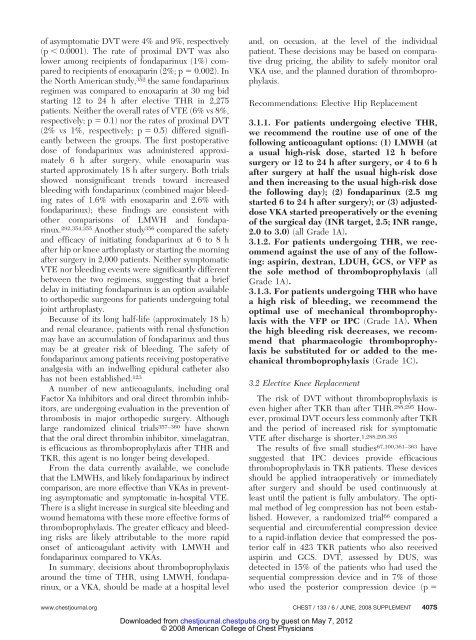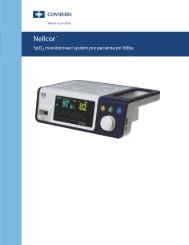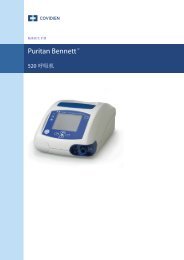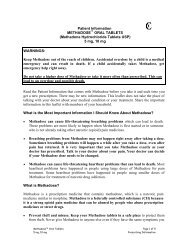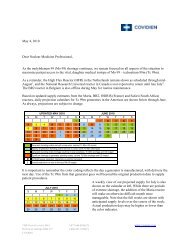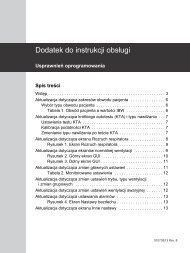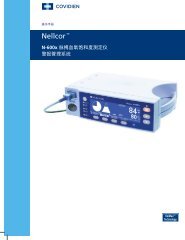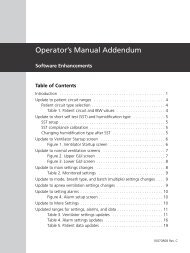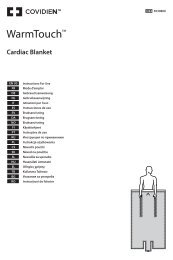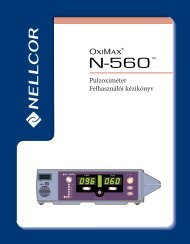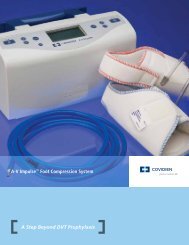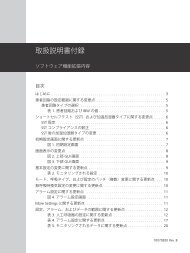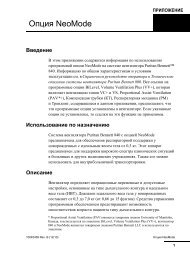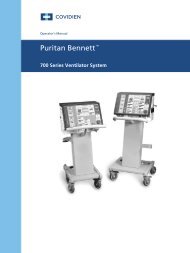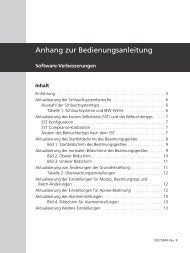Prevention of Venous Thromboembolism - Covidien
Prevention of Venous Thromboembolism - Covidien
Prevention of Venous Thromboembolism - Covidien
You also want an ePaper? Increase the reach of your titles
YUMPU automatically turns print PDFs into web optimized ePapers that Google loves.
<strong>of</strong> asymptomatic DVT were 4% and 9%, respectively<br />
(p � 0.0001). The rate <strong>of</strong> proximal DVT was also<br />
lower among recipients <strong>of</strong> fondaparinux (1%) compared<br />
to recipients <strong>of</strong> enoxaparin (2%; p � 0.002). In<br />
the North American study, 352 the same fondaparinux<br />
regimen was compared to enoxaparin at 30 mg bid<br />
starting 12 to 24 h after elective THR in 2,275<br />
patients. Neither the overall rates <strong>of</strong> VTE (6% vs 8%,<br />
respectively; p � 0.1) nor the rates <strong>of</strong> proximal DVT<br />
(2% vs 1%, respectively; p � 0.5) differed significantly<br />
between the groups. The first postoperative<br />
dose <strong>of</strong> fondaparinux was administered approximately<br />
6 h after surgery, while enoxaparin was<br />
started approximately 18 h after surgery. Both trials<br />
showed nonsignificant trends toward increased<br />
bleeding with fondaparinux (combined major bleeding<br />
rates <strong>of</strong> 1.6% with enoxaparin and 2.6% with<br />
fondaparinux); these findings are consistent with<br />
other comparisons <strong>of</strong> LMWH and fondaparinux.<br />
292,354,355 Another study 356 compared the safety<br />
and efficacy <strong>of</strong> initiating fondaparinux at 6 to 8 h<br />
after hip or knee arthroplasty or starting the morning<br />
after surgery in 2,000 patients. Neither symptomatic<br />
VTE nor bleeding events were significantly different<br />
between the two regimens, suggesting that a brief<br />
delay in initiating fondaparinux is an option available<br />
to orthopedic surgeons for patients undergoing total<br />
joint arthroplasty.<br />
Because <strong>of</strong> its long half-life (approximately 18 h)<br />
and renal clearance, patients with renal dysfunction<br />
may have an accumulation <strong>of</strong> fondaparinux and thus<br />
may be at greater risk <strong>of</strong> bleeding. The safety <strong>of</strong><br />
fondaparinux among patients receiving postoperative<br />
analgesia with an indwelling epidural catheter also<br />
has not been established. 123<br />
A number <strong>of</strong> new anticoagulants, including oral<br />
Factor Xa inhibitors and oral direct thrombin inhibitors,<br />
are undergoing evaluation in the prevention <strong>of</strong><br />
thrombosis in major orthopedic surgery. Although<br />
large randomized clinical trials 357–360 have shown<br />
that the oral direct thrombin inhibitor, ximelagatran,<br />
is efficacious as thromboprophylaxis after THR and<br />
TKR, this agent is no longer being developed.<br />
From the data currently available, we conclude<br />
that the LMWHs, and likely fondaparinux by indirect<br />
comparison, are more effective than VKAs in preventing<br />
asymptomatic and symptomatic in-hospital VTE.<br />
There is a slight increase in surgical site bleeding and<br />
wound hematoma with these more effective forms <strong>of</strong><br />
thromboprophylaxis. The greater efficacy and bleeding<br />
risks are likely attributable to the more rapid<br />
onset <strong>of</strong> anticoagulant activity with LMWH and<br />
fondaparinux compared to VKAs.<br />
In summary, decisions about thromboprophylaxis<br />
around the time <strong>of</strong> THR, using LMWH, fondaparinux,<br />
or a VKA, should be made at a hospital level<br />
and, on occasion, at the level <strong>of</strong> the individual<br />
patient. These decisions may be based on comparative<br />
drug pricing, the ability to safely monitor oral<br />
VKA use, and the planned duration <strong>of</strong> thromboprophylaxis.<br />
Recommendations: Elective Hip Replacement<br />
3.1.1. For patients undergoing elective THR,<br />
we recommend the routine use <strong>of</strong> one <strong>of</strong> the<br />
following anticoagulant options: (1) LMWH (at<br />
a usual high-risk dose, started 12 h before<br />
surgery or 12 to 24 h after surgery, or 4 to 6 h<br />
after surgery at half the usual high-risk dose<br />
and then increasing to the usual high-risk dose<br />
the following day); (2) fondaparinux (2.5 mg<br />
started 6 to 24 h after surgery); or (3) adjusteddose<br />
VKA started preoperatively or the evening<br />
<strong>of</strong> the surgical day (INR target, 2.5; INR range,<br />
2.0 to 3.0) (all Grade 1A).<br />
3.1.2. For patients undergoing THR, we recommend<br />
against the use <strong>of</strong> any <strong>of</strong> the following:<br />
aspirin, dextran, LDUH, GCS, or VFP as<br />
the sole method <strong>of</strong> thromboprophylaxis (all<br />
Grade 1A).<br />
3.1.3. For patients undergoing THR who have<br />
a high risk <strong>of</strong> bleeding, we recommend the<br />
optimal use <strong>of</strong> mechanical thromboprophylaxis<br />
with the VFP or IPC (Grade 1A). When<br />
the high bleeding risk decreases, we recommend<br />
that pharmacologic thromboprophylaxis<br />
be substituted for or added to the mechanical<br />
thromboprophylaxis (Grade 1C).<br />
3.2 Elective Knee Replacement<br />
The risk <strong>of</strong> DVT without thromboprophylaxis is<br />
even higher after TKR than after THR. 288,295 However,<br />
proximal DVT occurs less commonly after TKR<br />
and the period <strong>of</strong> increased risk for symptomatic<br />
VTE after discharge is shorter. 1,288,295,303<br />
The results <strong>of</strong> five small studies 67,100,361–363 have<br />
suggested that IPC devices provide efficacious<br />
thromboprophylaxis in TKR patients. These devices<br />
should be applied intraoperatively or immediately<br />
after surgery and should be used continuously at<br />
least until the patient is fully ambulatory. The optimal<br />
method <strong>of</strong> leg compression has not been established.<br />
However, a randomized trial 66 compared a<br />
sequential and circumferential compression device<br />
to a rapid-inflation device that compressed the posterior<br />
calf in 423 TKR patients who also received<br />
aspirin and GCS. DVT, assessed by DUS, was<br />
detected in 15% <strong>of</strong> the patients who had used the<br />
sequential compression device and in 7% <strong>of</strong> those<br />
who used the posterior compression device (p �<br />
www.chestjournal.org CHEST / 133 /6/JUNE, 2008 SUPPLEMENT 407S<br />
Downloaded from<br />
chestjournal.chestpubs.org by guest on May 7, 2012<br />
© 2008 American College <strong>of</strong> Chest Physicians


